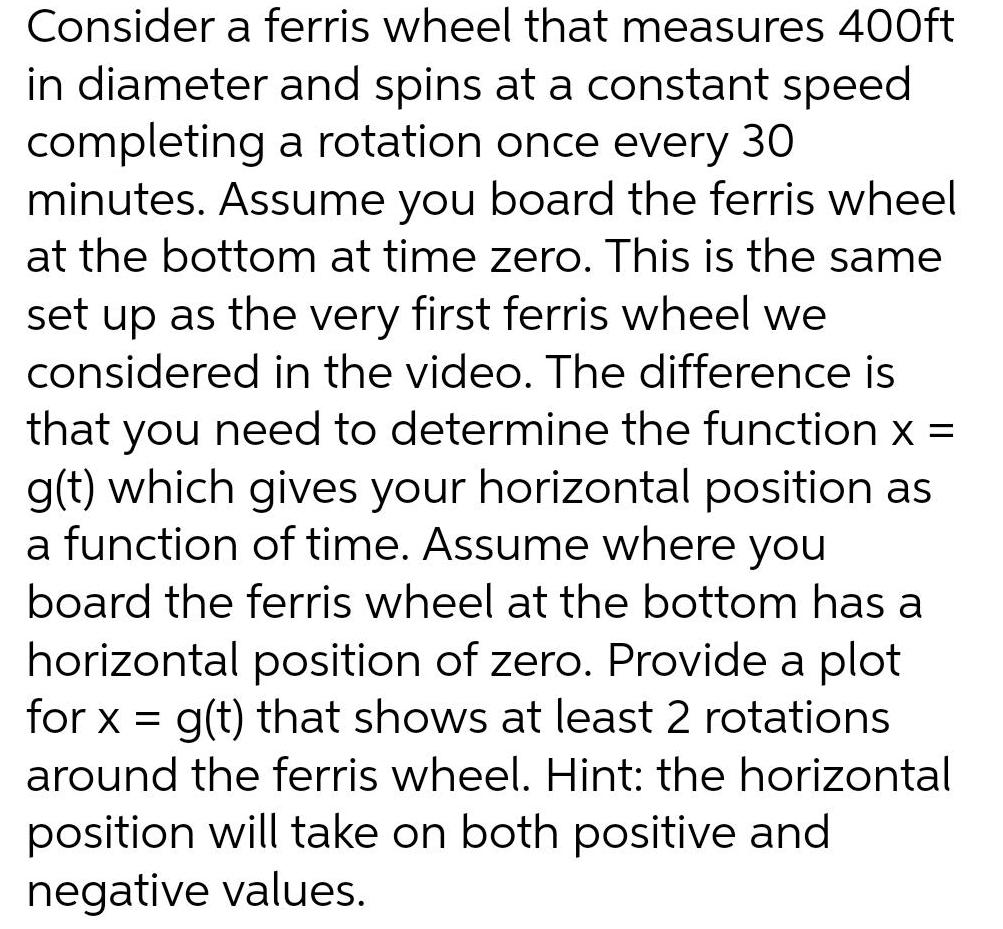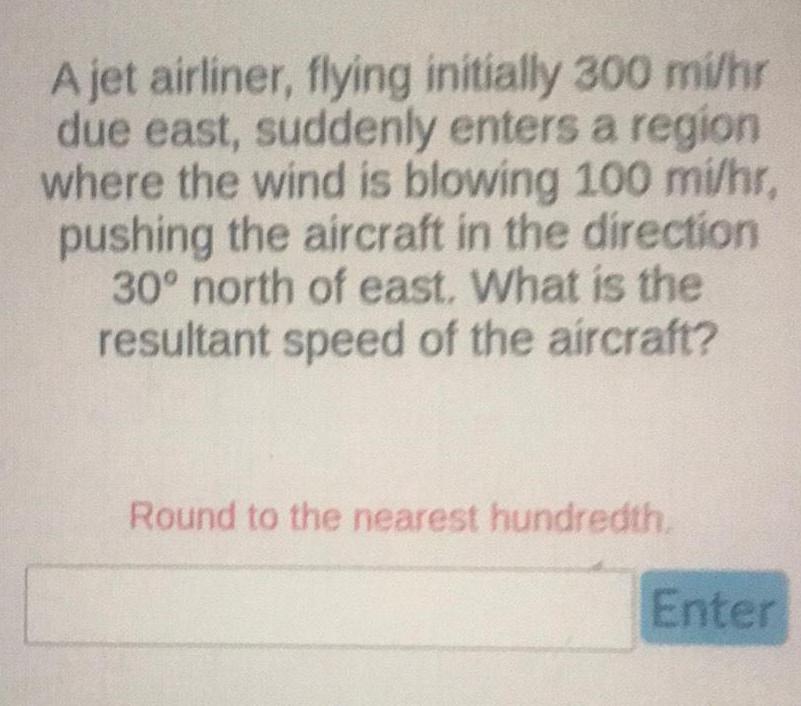Vector Calculus Questions and Answers

Calculus
Vector Calculusf(x, y) =x/y , P(8, 1), u = 3/5i +4/5 j
(a) Find the gradient of f.
Vf(x, y) =
(b) Evaluate the gradient at the point P.
Vf(8, 1) =
(c) Find the rate of change of f at P in the direction of the vector u.
Duf(8, 1) =

Calculus
Vector CalculusA water sprinkler sends water out in a circular pattern. Determine how large an area is watered. The radius of watering is 24 ft. Use 3.14 for π .
The area of the circle is ft²
(Type a whole number or decimal rounded to the nearest hundredth as needed.)

Calculus
Vector CalculusGiven a triangle with a leg of 8 km and hypotenuse 22 km, find the missing side.
The length of the missing side is km.
(Round to the nearest thousandth.)


Calculus
Vector CalculusUse the distributive property to multiply
a. -6(4x² - 2x - 11)
b. x(x⁴ + 8x² - 11)
c. 2x² (2x²-x-3)
d. x² (3x³-8x² - 6x)




Calculus
Vector CalculusA value of sinh x or cosh x is given. Use the definitions and the identity cosh² x - sinh² x = 1 to find the value of the other indicated hyperbolic function.
sinh x = 5/12 , cosh x =
sinh x = -4/3, tanh x=
sinh x = 3/4, coth x=
cosh x = 5/3, x>0, sinh x=
cosh x= 17/15, x < 0, csch x =

Calculus
Vector CalculusRewrite the expression as an equivalent expression functions greater than 1.
8 cos2x

Calculus
Vector CalculusUse a half-angle formula to find the exact value of the expression.
COS 5π/12

Calculus
Vector CalculusConsider a ferris wheel that measures 400ft in diameter and spins at a constant speed completing a rotation once every 30 minutes. Assume you board the ferris wheel at the bottom at time zero. This is the same set up as the very first ferris wheel we considered in the video. The difference is that you need to determine the function x= g(t) which gives your horizontal position as a function of time. Assume where you board the ferris wheel at the bottom has a horizontal position of zero. Provide a plot for x = g(t) that shows at least 2 rotations around the ferris wheel. Hint: the horizontal position will take on both positive and negative values.
![Let . a,β Z[i] with prime. Prove that if π|a, then 7 and a are relatively prime.
Let , a. β € Z[i] with prime. Prove that if π| aß, then πa or π | β](https://media.kunduz.com/media/sug-question/raw/84409465-1657902422.4934793.jpeg?w=256)
Calculus
Vector CalculusLet . a,β Z[i] with prime. Prove that if π|a, then 7 and a are relatively prime.
Let , a. β € Z[i] with prime. Prove that if π| aß, then πa or π | β

Calculus
Vector CalculusFind the position and velocity vectors of a particle that has the given acceleration and the given initial velocity and position: a(t) = tj + tk, v(1) = 5j, and r(1) = 0.

Calculus
Vector CalculusFind the equation of the plane that passes through the points (2, 2, 1) and (-1, 1, -1) and is perpendicular to the plane 2x - 3y + z = 3.

Calculus
Vector CalculusFind an equation of the normal plane to a = sin(2t), y = cos(2t), z = 4t at the point (0, 1, 2π).

Calculus
Vector CalculusSketch the plane curve r(t) = ti+t³j and the vectors T(t) and N(t) when t = 1.
(Do NOT try to find T(t) and N(t)).
Find the scalar tangential component of acceleration at of a particle with position vector r(t)
=5ti + (t² + 5)j.

Calculus
Vector Calculus(a) Find the point at which the given lines intersect.
r = (3, 2, 0) + t(2, -2, 3)
r=(5, 0, 3) + s(-2, 2, 0)
(x, y, z) =
(b) Find an equation of the plane that contains these lines.

![Evaluate the Riemann sum for f(x) = ln(x) - 0.7 over the interval [1, 5] using eight subintervals, taking the sample points to be midpoints.](https://media.kunduz.com/media/sug-question/raw/84396596-1657807653.931009.jpeg?w=256)
Calculus
Vector CalculusEvaluate the Riemann sum for f(x) = ln(x) - 0.7 over the interval [1, 5] using eight subintervals, taking the sample points to be midpoints.

Calculus
Vector CalculusShow all work and upload a file to complete the following:
Given that f = 3/1+x and g = 3x - 4,
a) Find the composite function, f.g
b) Determine the domain of the composite function.

Calculus
Vector CalculusFind the scalar equation of the plane that contains the point (2,-1,5) as well as the line (x,y,z) = (1,2,3) + t(3,4,-3)

Calculus
Vector CalculusWhat is the radius of a circle in which an angle of 3 radians cuts off an arc length of 30 cm?



Calculus
Vector CalculusFrom Times Square in New York City, you can see Central Park and the Empire State Building. The approximate distance from Times Square to Central Park is 2 miles, Central Park to the Empire State Building is 1.3 miles, and Empire State Building to Times Square is 0.9 miles. What is the approximate angle to the other two landmarks from Times Square?

Calculus
Vector CalculusFind a second-degree polynomial P such that P(3) = 17, P'(3) = 14, and P"(3) = 6.
P(x) =

Calculus
Vector CalculusGraph the curve with parametric equations x = sin(t), y = 3 sin(2t), z = sin(3t).

Calculus
Vector CalculusAt what point on the curve x = t³, y = 6t, z = t4 is the normal plane parallel to the plane 6x +12y - 8z = 3?

Calculus
Vector CalculusSuppose a = 11 and b = 6.
Find an exact value or give least two decimal places:
tan (A) =
sec (A) =
csc (A) =
cot (A) =


Calculus
Vector CalculusFind the length of the curve correct to four decimal places. (Use your calculator to approximate the integral.)
r(t) = (sin(t), cos(t), tan(t)), 0≤t≤π/4.


Calculus
Vector CalculusSolve the following quadratic inequality: 3x² + 5x − 2 ≤ 0
Write your answer in interval notation.

Calculus
Vector CalculusEvaluate the following expressions. The answer must be given as a fraction, NO DECIMALS. If the answer involves a square root it should be entered as sqrt. For instance, the square root of 2 should be written as sqrt(2).
If tan (θ) = -9/7 and sin(θ)<0, then find
(a) sin(θ)
(b) cos(θ)
(c) sec (θ)
(d) csc(θ)
(e) cot(θ)

Calculus
Vector CalculusSolve: |4x-8| > 1
Give your answer as an interval.
Note: Type oo for the infinity symbol ∞ and U for the union symbol U.

Calculus
Vector CalculusUse the hal zeros theorem to list all possible rational zeros of the following.
f(x)= 10x³ + 6x² + 8x + 4
Be sure that no value in your list appears more than once.

Calculus
Vector CalculusThe y-coordinate of a particle in curvilinear motion is given by y-8.71³-13.5t, where y is in inches and t is in seconds. Also, the particle
has an acceleration in the x-direction given by ax = 3.4t in./sec². If the velocity of the particle in the x-direction is 12.7 in./sec when t=0,
calculate the magnitudes of the velocity v and acceleration a of the particle when t = 3.3 sec. Construct vand a in your solution.
Answers: When t - 3.3 sec.
V-
a-
i
in./sec
in./sec²

Calculus
Vector CalculusDetermine if the specified linear transformation is (a) one-to-one and (b) onto. Justify your answer.
T(X₁X2 X3 X4) = (0,X3 +X4X3 X4 X3 X4)
a. Is the linear transformation one-to-one?
1000
OA. T is not one-to-one because the standard matrix A has a free variable.
OB. T is not one-to-one because the columns of the standard matrix A are linearly independent.
OC. T is one-to-one because the column vectors are not scalar multiples of each other.
OD. T is one-to-one because T(x)=0 has only the trivial solution.
b. Is the linear transformation onto?
OA. T is not onto because the first row of the standard matrix A is all zeros.
OB. T is onto because the standard matrix A does not have a pivot position for every row.
OC. T is not onto because the columns of the standard matrix A span Rª
OD. T is onto because the columns of the standard matrix A span R¹

Calculus
Vector CalculusFind all y-intercepts and x-intercepts of the graph of the function.
f(x) = -x² - 2x+48
If there is more than one answer, separate them with commas.
Click on "None" if applicable.
y-intercept(s):
x-intercept(s):
None
0/0
X
0/6
0,0,...
5
3/6
?

Calculus
Vector CalculusFind a vector equation and parametric equations for the line. (Use the parameter t.)
the line through the point (8, -5, 6) and parallel to the vector (1, 3, -2/3)
r(t) =
(x(t), y(t), z(t)) =

Calculus
Vector CalculusLet P be a point not on the line L that passes through the points Q and R. The distance d from the point P to the line L is
d=la x b| / lal
where a = QR and b = QP.
Use the above formula to find the distance from the point to the given line.
(5, 2, -1); x = 2 + t, y = 2 - 2t, z = 4 - 3t

Calculus
Vector CalculusDetermine whether the lines L₁ and L₂ are parallel, skew, or intersecting.
L₁: x = 9 + 6t, y = 12 - 3t, z = 3 + 9t
L₂: x = 3 + 12s, y = 9 - 6s, z = 12 + 15s
parallel
skew
intersecting

Calculus
Vector CalculusFind parametric equations for the line. (Use the parameter t.) the line through (3, 3, 0) and perpendicular to both i + j and j + k
(x(t), y(t), z(t)) =
Find the symmetric equations.
x-3=y- 3 = -z
x+ 3 = -(y + 3) = z
x3 = -(y - 3) = z
-(x- 3) = y - 3 = z
x+ 3 = -(y + 3), z = 0

Calculus
Vector Calculus. If * x (x z) = (xy) xz, then which of the following option is correct ?
(a) x and y are collinear.
(b) and z are collinear.
(c) y and z are collinear.
(d) None

Calculus
Vector Calculus(5 points) Let V be a vector space over some field F
a) (3 points) Let W be a subspace of a vector space V. Suppose x, y € V are not in W. Show that if re span (W,y) then y span (W, x)
b) (2 point) Give an example of a vector space V, a subspace W CV, and vectors x, y € V such that are span (W,y) but y & span (W, x)

Calculus
Vector CalculusA Ferris wheel rotates 2852° per ride. How far would a rider seated 8 feet from the center of the Ferris wheel travel during the ride?
Round your answer to the nearest thousandth.


Calculus
Vector CalculusA jet airliner, flying initially 300 mi/hr due east, suddenly enters a region where the wind is blowing 100 mi/hr, pushing the aircraft in the direction 30° north of east. What is the resultant speed of the aircraft?

Calculus
Vector CalculusGraph the parabola.
y=x² + 4x+7
Plot five points on the parabola: the vertex, two points to the left of the vertex, and two points to the right of the vertex. Then click on the graph-a-function button.